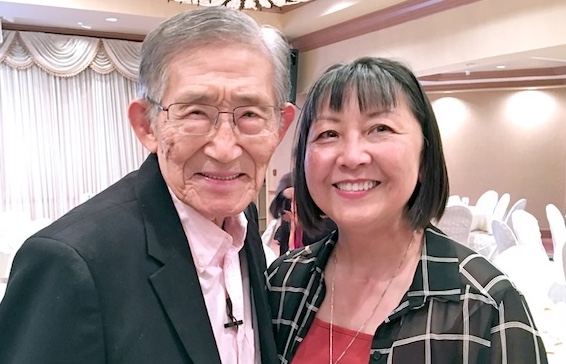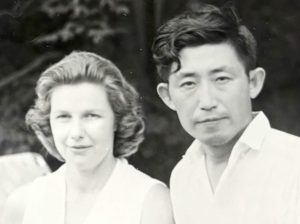Investigative journalist helped free
death-row inmate, forge pan-Asian coalition.
By George Toshio Johnston, Senior Editor
Subject of imperial Japan and teen soldier in the Japanese military. Immigrant. Outcast. Pioneer. Entrepreneur. Mentor. Liver transplant recipient. Husband, father, grandfather and great grandfather. And, of course, journalist. The many lives of Kyung Won Lee, for whom the adjectives passionate, fiery, caring, earthy, raw, inspiring, challenging, irreverent, committed and loyal could all apply, came to an end March 8 in Sacramento, Calif. He was 96.

K.W. Lee and Ranko Yamada in 2018 (Photo: George Toshio Johnston)
Of his many lives, each of which could be the subject of a book or movie, it was the award-winning and impactful investigative journalism career of K.W. Lee, as he was known to most, for which he will be remembered and studied. In fact, two movies inspired by Lee’s journalism were made: the whitewashed Hollywood version, 1989’s “True Believer,” and the Emmy-award winning documentary from 2022, “Free Chol Soo Lee.” (See March 18, 2022 Pacific Citizen, tinyurl.com/mpa5mzc7)
Both were inspired by K.W. Lee’s reporting on the circumstances of another man — a fellow Korean immigrant with the same last name — that found him on death row for a brazen murder that he not only did not commit, it was a slaying for which he had absolutely no involvement.
That man’s name was Chol Soo Lee, who was eventually set free thanks to his namesake’s dogged investigative reporting. But postprison, a grateful Chol Soo Lee could not adjust to life on the outside and fell into a life of ignominy. By 2014, he was dead at 62. It would haunt K.W. Lee for the rest of his days.
The esteem in which K.W. Lee was held by his fellow journalists was mountain high and river deep. Kenji Taguma, editor-in-chief of San Francisco-based Nichi Bei News, for which Lee contributed a column, told Pacific Citizen, “K.W. Lee clearly demonstrated the power of the pen to uncover truth, and move people into action. We will do our best to continue a shared legacy of community-minded journalism. A few years ago, we started a K.W. Lee Reporting Fund to help support community news writing and honor the pioneering legacy of Mr. Lee.”
Tae Hyun Kim, a journalism professor at California State University Northridge and board member of the K.W. Lee Center for Leadership, said, “K.W. Lee emphasized the importance of solidarity among diverse minority communities. He believed that the role of journalism was not to separate racial communities but to help them unite and speak with a collective voice.”
It was during Japan’s colonization of Korea when K.W. Lee was born on June 1, 1928, in Kaesong, in what is now North Korea. In that period, Koreans were forced to take on Japanese names, and during that life, Lee had to use the surname Umeda.

K.W. Lee as a teen soldier in Japan’s army air force
(Photo: K. W. Lee Family)
As a14-year-old during World War II, he served in the Japanese army air force’s special volunteer air cadet corps, where he endured anti-Korean bullying from some higher-ranking superiors. He would learn how to become a flight radar operator and meet Japanese pilots just a few years older than he who would die on kamikaze missions.
After Japan surrendered to the United States in 1945, one of his superiors pulled him aside and told him that his life would be better if he returned to Korea. He did, later enrolling at Korea University to study English.
Months before the Korean War began in 1950, Lee left Korea for the United States, where he and his small group of fellow Korean students found themselves stranded once the war was in progress. He earned a B.A. in journalism from West Virginia University and an M.A. in journalism from the University of Illinois, Urbana-Champaign.
Lee soon realized in that period that returning to Korea, where he and a professor there had wanted to start a newspaper “based on the American principles of an independent press,” would not be wise — the professor was put to death by Korea’s repressive regime. Lee then became the target of possible deportation after the Korean embassy began the process of revoking his student visa after he wrote a “sarcastic editorial” about Korean strongman President Syngman Rhee.
He avoided that fate by landing a job at the Kingsport Times News in Tennessee — and yet another life began when Lee became the first Korean immigrant journalist to work for a mainstream American newspaper.
Ironically, when Lee returned to South Korea for the 1988 Summer Olympic Games as a representative for Korean American media, he was treated like a dignitary. It was during that trip that he also stumbled across a life-changing revelation about his father, something that occurred before he was born.
While researching the life of Korean independence leader Ahn Chang Ho, he saw a photo of his father. For most of Lee’s life, he only knew his father as a peddler. He learned instead that his father, Hyung Soon Lee, was seen as a hero for protesting against Japanese occupation, for which he was imprisoned. In the book “East to America: Korean American Life Stories” Lee is quoted: “I feel like I’ve been cheated by life, because it had been a family secret, and I came to know it too late.” To win his father’s freedom, the family sold the confectionary factory he had founded.

Peggy and K. W. Lee (Photo: K. W. Lee Family)
Staying in the American South, by 1958 Lee found himself in West Virginia working for the Charleston Gazette, where he went on to cover civil rights and document the crushing poverty of the lives of coal miners. It was there where he met his future wife, a White emergency room nurse named Peggy N. Flowers at a time and place where such interracial and intercultural marriages were not just uncommon, they were generally unwelcome. But the Lees would nevertheless bring three children into the world.
Hired by the now-defunct Sacramento Union, Lee and family moved across the country in 1970 to California, where his investigative journalism turned its focus on backroom deals and corruption in the government and by state legislators.
But it was a 1973 gang-related slaying in miles-away San Francisco, brought to his attention by a nascent pan-Asian American coalition led by Ranko Yamada that would forever change K.W. Lee’s life. He would devote countless hours and typewriter ribbons on the Chinatown murder, filing more than 100 articles that helped prove Chol Soo Lee — a self-admitted “street punk” who handily fit a profile for a city that wanted to pin the crime on someone, anyone who looked the part, regardless of the truth — had been the victim of a gross miscarriage of justice. In 1982, Chol Soo Lee was acquitted and was soon a free man again. A big part of that freedom was thanks to K.W. Lee. (See June 15, 2018 Pacific Citizen.)
Yet another of K.W. Lee’s lives, perhaps inspired in part by the never-fulfilled idea of founding a newspaper in Korea, began in 1979 when his entrepreneurial yearnings led him to co-found, with the help of fellow Sacramento Union staffer Steve Chanecka and future Los Angeles Times staffer Randy Hagihara, the first English-language newspaper focused on the growing Korean American community: Koreatown Weekly. (See June 15, 2018 Pacific Citizen)
The nearly five-year long enterprise was produced in a way the team referred to as “I-5 journalism.” On a weekly basis, Lee and Chanecka drove nearly 800 miles between Los Angeles and Sacramento, doing prepress in Los Angeles and composing and printing the paper in Sacramento.
Lee credited former Pacific Citizen editor Harry Honda for serving as a “midwife” for the paper’s birth: Well before the advent of desktop publishing, Honda guided them on how to use the Pacific Citizen’s photo typesetter. When they didn’t finish until about 3 a.m., they realized they needed to try another tack to produce the paper. Although Koreatown Weekly eventually failed, it did serve as a template of sorts when, a few years later the Korea Times launched its English-language edition for Los Angeles and tapped K.W. Lee to lead the operation.
It was 1990 and the timing was literally combustible: tensions between Korean shopkeepers in Black neighborhoods was rising, with residents in mostly African American South and South Central Los Angeles resentful of the immigrants. Robberies of Korean-run liquor stores and homicides of storeowners became an L.A. news staple.
The slaying of a Black teenager named Latasha Harlins on March 16, 1991, perceived to be shoplifting by a Korean immigrant shopkeeper named Soon Ja Du case was gasoline; she was found by a jury to be guilty of voluntary manslaughter but given probation by the judge in the case. The match that ignited days and nights of rioting came on April 29, 1992 — known to L.A.’s Korean community as Sa-I-Gu — when the not guilty verdict was announced for the Los Angeles Police Department officers charged in the beating of Rodney King.
Ironically, Lee, whose position and leadership might have been able to ameliorate some of the worst results of the uprising could do nothing more than pen a May 11, 1992 editorial titled “Never Again” from his hospital bed. He was awaiting a liver transplant. It was a point of pride for him that he was alive, as he put it, thanks to a liver of a deceased Chicano gangbanger.
The accolades that came Lee’s way included the Asian American Journalists Association presenting him with its “Excellence in Print Journalism” award at its first convention in 1987 and being inducted into the Newseum, the now-defunct museum that honored journalists. He also was recognized by National Headliners Club in 1974 and 1983, the AP News Executive Council, the Columbia University Graduate School of Journalism and the Freedom Forum. In 2010, Lee was honored again by AAJA as a pioneer Asian in U.S. journalism.
His biggest career-related laurels , however, may have been the creation of the K.W. Lee Center for Leadership in 2003 and his participation in the 2022 documentary “Free Chol Soo Lee,” which won an outstanding historical documentary Emmy on Sept. 26, 2024 at the 45th annual News & Documentary Emmy Awards.
Personally, over the course of his many lives, it was his and his wife’s three children of which Lee was most proud. In a joint statement from Shane Lee, Sonia Cook and Diana Regan, they said, “Our Dad had an innate curiosity about people which showed when he engaged with our friends and others around him. He would ask about their family history and heritage, gathering stories and uncovering details. His ability to connect with people came from a genuine desire to know their experiences. That same curiosity and empathy drove his journalism — he wasn’t just searching for facts, but for the human stories behind them.”
Kyung Won Lee was predeceased by his wife, Peggy, in 2011. His survivors include son Shane Lee (Sandee), daughters Sonia Cook (Victor) and Diana Regan (Alan); six grandchildren and three great grandchildren. His family asked that anyone wishing to honor him make donations in his name to the K.W. Lee Center for Leadership, at kwleecenter.org.



